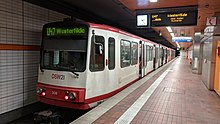
Dortmund is the third-largest city in North Rhine-Westphalia, after Cologne and Düsseldorf, and the ninth-largest city in Germany. With a population of 612,065 inhabitants, it is the largest city of the Ruhr as well as the largest city of Westphalia. It lies on the Emscher and Ruhr rivers in the Rhine-Ruhr Metropolitan Region, the second biggest metropolitan region by GDP in the European Union, and is considered the administrative, commercial, and cultural centre of the eastern Ruhr. Dortmund is the second-largest city in the Low German dialect area, after Hamburg.
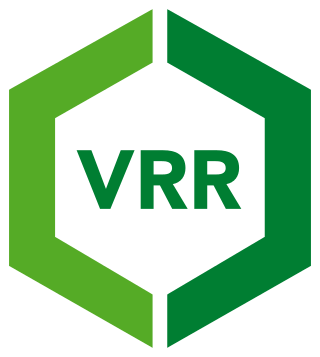
The Verkehrsverbund Rhein-Ruhr, abbreviated VRR, is a public transport association (Verkehrsverbund) in the German state of North Rhine-Westphalia. It covers most of the Ruhr area, as well as neighbouring parts of the Lower Rhine region, including Düsseldorf and thus large parts of the Rhine-Ruhr conurbation. It was founded on 1 January 1980, and is Europe’s largest body of such kind, covering an area of some 5,000 km2 (1,900 sq mi) with more than 7.8 million inhabitants, spanning as far as Dorsten in the north, Dortmund in the east, Langenfeld in the south, and Mönchengladbach and the Dutch border in the west.

Dortmund Hauptbahnhof is the main railway station in Dortmund, North Rhine-Westphalia, Germany. The station's origins lie in a joint station of the Köln-Mindener Eisenbahn and Bergisch-Märkische Eisenbahn which was built north of the city centre in 1847. That station was replaced by a new station, erected in 1910 at the current site. It featured raised embankments to allow a better flow of traffic. At the time of its opening, it was one of the largest stations in Germany. It was, however, destroyed in an Allied air raid on 6 October 1944.
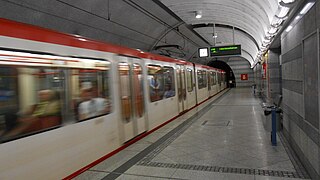
The Dortmund Stadtbahn is a light rail system in the German city of Dortmund and is integrated in the Rhine-Ruhr Stadtbahn network. Its network consists of eight lines and is operated by Dortmunder Stadtwerke, which is operating under the brand DSW21 since 2005.

Dortmund Stadthaus station is an important railway station of the inner city of Dortmund in the German state of North Rhine-Westphalia. It is located in the inner city at the junction of Ruhrallee (B54) and Märkischen Straße, near the Stadthaus, a municipal office building. It is classified by Deutsche Bahn as a category 5 station. The above-ground section of the station is served by Rhine-Ruhr S-Bahn line S 4 and the underground section is served by lines U41, U45, U47 and U49 of the Dortmund Stadtbahn.

Dortmund-Dorstfeld is an S-Bahn station in Dortmund in the German state of North Rhine-Westphalia. It the second most important S-Bahn node in the city after Dortmund Hauptbahnhof. It has four above-ground tracks, which are accessible via two island platforms and two underground tracks that are accessible via side platforms. The station is classified as a category 3 station. It is served by Rhine-Ruhr S-Bahn lines S1, S2 and S4.

Dortmund-Wischlingen is a railway station on the Welver–Sterkrade railway situated in Dortmund in western Germany. It is classified by Deutsche Bahn as a category 6 station. It is served by Rhine-Ruhr S-Bahn line S 2 every 30 minutes.
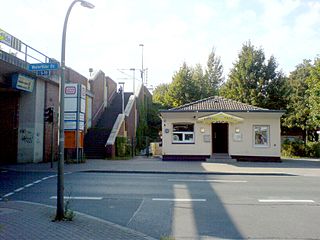
Dortmund-Westerfilde is a railway station on the Welver–Sterkrade railway situated in Dortmund in western Germany. It is classified by Deutsche Bahn as a category 6 station. It is served by Rhine-Ruhr S-Bahn line S 2 every 30 minutes. It offers connections to line U47 of the Dortmund Stadtbahn at 10-minute intervals on working days as well as two bus routes, 470 (Mengede – Kirchlinde – Lütgendortmund – Oespel and 471, both operated by Dortmunder Stadtwerke at 20-minute intervals on working days.

Dortmund-Mengede station is located in the Dortmund suburb of Mengede in the German state of North Rhine-Westphalia. The station was opened in 1848 as part of the trunk line of the former Cologne-Minden Railway Company.

Dortmund University station is an underground S-Bahn station on the line between Dortmund and Bochum in the German state of North Rhine-Westphalia. The station was opened on 24 September 1983 by Deutsche Bundesbahn on a new line built between Bochum-Langendreer and Dortmund-Dorstfeld. Like other stations on this line, it is served only by passenger trains.
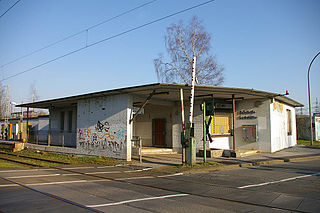
Dortmund-Kruckel station lies on the border between the suburbs of Dortmund-Kruckel and Dortmund-Persebeck of the city of Dortmund in the German state of North Rhine-Westphalia on the Elberfeld–Dortmund line. The station is currently classified as a category 6 station. It is served by regional services and Rhine-Ruhr S-Bahn line S 5.

Dortmund-Barop station is on Barop Marktplatz in the Hombruch district of the city of Dortmund in the German state of North Rhine-Westphalia on the Elberfeld–Dortmund line. The station is currently classified as a category 5 station. It is served by regional services and Rhine-Ruhr S-Bahn line S 5.

Dortmund-Nette/Oestrich station is located in the city of Dortmund in the German state of North Rhine-Westphalia. It is on a link between the Welver–Sterkrade railway and the Duisburg–Dortmund railway built for the opening of the line S2 of the Rhine-Ruhr S-Bahn. The line and station opened on 2 June 1991. It is classified by Deutsche Bahn as a category 6 station.
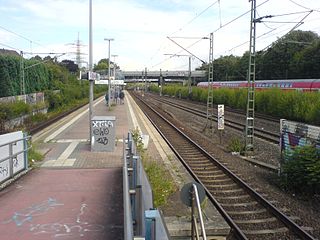
Dortmund-Marten Süd station is a railway station in the Dortmund district of Marten in the German state of North Rhine-Westphalia. It is classified by Deutsche Bahn as a category 6 station and was opened on 30 May 1964. It is now located on a new line completed between Dortmund-Dorstfeld and Germania on 3 June 1984 and electrified between Dortmund-Marten Süd station and Germania on 28 August 1987.
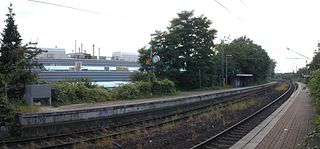
Dortmund West station is a railway station in the Dortmund district of Marten in the German state of North Rhine-Westphalia. It is classified by Deutsche Bahn as a category 6 station. It was opened on 3 June 1984 on the Osterath–Dortmund Süd railway completed between the old Dortmund-Dorstfeld station and the old Dortmund Süd (south) station by the Rhenish Railway Company on 19 November 1874 and electrified on 25 May 1984. It is proposed to build platforms on the Elberfeld–Dortmund railway to provide interchange with S-Bahn line S 5.

Dortmund-Körne West station is a railway station in the Dortmund district of Körne in the German state of North Rhine-Westphalia. It is classified by Deutsche Bahn as a category 6 station. It was opened on 3 June 1984 on the Welver–Sterkrade railway completed between Welver and the old Dortmund Süd (south) station by the Royal Westphalian Railway Company on 15 May 1876 and electrified on 25 May 1984.
Dortmund-Brackel is a railway station in the Dortmund district of Brackel in the German state of North Rhine-Westphalia. It is classified by Deutsche Bahn as a category 5 station. It was opened on 15 May 1976 on the Welver–Sterkrade railway completed between Welver and the old Dortmund Süd (south) station by the Royal Westphalian Railway Company on the same date and electrified on 25 May 1984. A station building was built in 1895, but it was demolished in 1985.
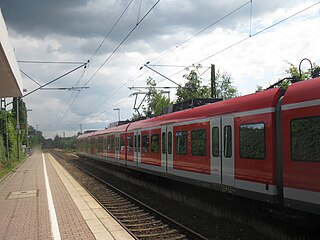
Dortmund-Asseln Mitte is a railway station in the Dortmund district of Asseln in the German state of North Rhine-Westphalia. It is classified by Deutsche Bahn as a category 6 station. It was opened in 1963 or 1964 on the Welver–Sterkrade railway completed between Welver and the old Dortmund Süd (south) station by the Royal Westphalian Railway Company on 15 May 1876 and electrified on 25 May 1984.

Dortmund-Wickede West is a railway station in the Dortmund district of Wickede in the German state of North Rhine-Westphalia. It is classified by Deutsche Bahn as a category 6 station. It was opened on 15 May 1876 on the Welver–Sterkrade railway completed between Welver and the old Dortmund Süd (south) station by the Royal Westphalian Railway Company on the same date and electrified on 25 May 1984. It was originally called Wickede-Asseln, but it was renamed Dortmund-Asseln between 1927 and 1930 and Dortmund-Wickede West on 3 June 1984.
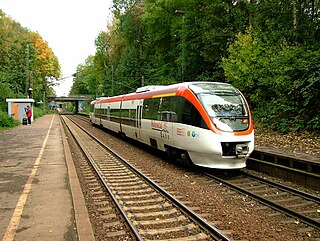
The Dortmund-Märkische Eisenbahn GmbH (DME) was a German train operating company, that operated the Dortmund–Hagen–Lüdenscheid train service from 30 May 1999 to 11 December 2004. It was a subsidiary of the Dortmunder Stadtwerke (74%) and the Märkische Verkehrsgesellschaft (26%), the municipal public transport operators of Dortmund and Märkischer Kreis.


